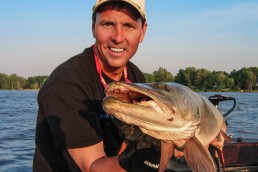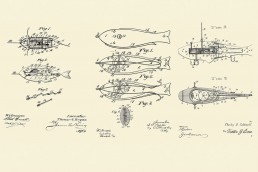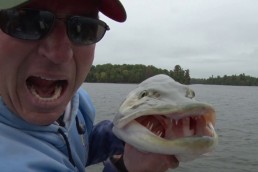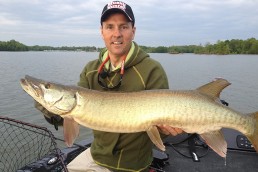Are Bigger Muskie Lures Better?
SHARE THIS POST
Muskie fishing is getting extremely physical.
I am not sure how this has all happened, but there is no question, right now, big baits rule. Double-ten bladed bucktails, Pounder Bulldawgs and nine-inch ShallowRaiders are just a few of the examples of some of the larger lures that have become the mainstay of today’s muskie hunter. The reason for this big bait revolution is simple. These mega-sized lures catch big muskies. In fact in 2012, I caught 55-, 53 1/4- and 52-inch muskies on each of the lures mentioned above.
Traditionally, the eastern muskie anglers from New York and Pennsylvania were the ones to be primarily trolling with giant lures in the nine- to 15-inch category. Then the explosion of the Minnesota muskie fishery happened and it just seems like those “Viking State” muskies prefer things “the bigger the better.” This approach has rubbed off on anglers across the muskie range, and now these large lures have been catching giant muskie across the entire range from Kentucky to Canada, and from Minnesota to New York.
Of course as Midwestern casters, we all choose to cast these beastly lures. This requires some beefed-up equipment and some stamina on your behalf. I use my nine-foot St. Croix Big Nasty to handle almost all of these large lures. Also, when it comes to handling the double-10 bucktails, nothing compares to the Shimano Tranx reel. I prefer the lower-speed version, which just happens to crank Cowgirls at high speeds very easily.
Line is very important, and 100-pound braid, such as that made by Vicious is a great option. Big bulky knots and 150-pound-test fluorocarbon leaders are also a must.
Are you enjoying this post?
You can be among the first to get the latest info on where to go, what to use and how to use it!
This equipment is certainly on the heavy side. Put one of these rod and reel combinations in your hand and it’s nothing like the equipment our fathers used. This is high-tech stuff. The ideal rods are lightweight yet super strong, with not a lot of flex in the rod tip. These rods are designed to throw lures weighing up to 16 ounces. Work them with rips, jerks and pauses. There’s lots of stress on the equipment and the body.
Your body is also something that has to be ready for this style of fishing. Not that you have to be in incredible shape to cast for muskies, or that it’s anything like playing basketball, football or other sports, but believe me, a day of casting these lures is work. So you need to be prepared and exercise before you go the big-bait route. If you are in decent shape and have the right equipment, you are prepared and ready to cast these giant lures.
Other than fishing bucktails, erratic rules the water when fishing big soft plastics and minnowbaits. When the water is warm, rip hard and fast. When the water is cold, longer pulls with pauses seem to work better. Don’t be intimidated by the size of the lures. Smaller muskies will eat these large offerings. In fact, less than 10 minutes before I caught a 53 1/4-inch muskie on a pounder Bulldawg, I boated a 32-incher on the same bait! It’s crazy but true. My point is that you can also catch numbers as well as big muskies on these big lures.
And these large lures are not just a fall option. Spring, summer and fall, don’t be afraid to go large. These baits get noticed and they are the preferred size forage for big muskies. Do big muskies eat smaller offerings? Absolutely. And you should always carry an assortment of smaller or more traditional muskie baits. Yet, you just can’t argue with some of the big muskies that are consistently being caught on these big baits.
They really are a game changer across the entire muskie range. If your mission is a 50-incher this season, these big lures are absolute musts. When at the winter sports shows, or browsing through catalogs (while doing arm curls), consider purchasing some of these super-sized lures and a rod/reel combination to handle them. These lures may look big on the shelf or when you hold them, but it’s amazing how small they look when they are in the mouth of a monster muskie.
MWO
SHARE THIS POST
Did you enjoy this post?
You can be among the first to get the latest info on where to go, what to use and how to use it!
Jim Saric
Jim Saric is a Legendary Angler in the Freshwater Fishing Hall of Fame, the host and executive producer of The Musky Hunter television series, editor at large of Musky Hunter magazine, a seven-time muskie tournament winner, and a contributing writer for numerous other publications.




